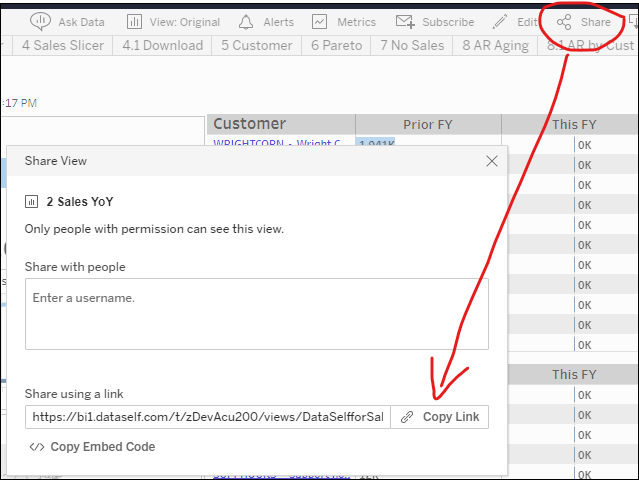Embed DataSelf's Tableau in NetSuite (WIP)
Work in progress! We’re using the article below to build the equivalent instructions for DataSelf. Please email support @dataself.com if you run into difficulties.
https://alphabold.com/creating-powerbi-custom-portlets-in-netsuite/
Part 1. Find the Tableau URL of the Dashboard or Report to Embed
Open Tableau Web Server in a web browser.
Open the dashboard or report to embed.
Click the Share icon on the top right.
Click Copy Link from the Share View window. This URL will be pasted in Part 2.
Important: If you don’t see the word "embed" in the URL above, add "&:embed=yes" at the end of it.
Part 2. Embed the URL into NetSuite
Here we’ll use NetSuite Custom Portlets.
We recommend installing SuiteCloud IDE. See articles below for further info:
https://netsuite.custhelp.com/app/answers/detail/a_id/79924 (SuiteScript Developer Guide)
https://netsuite.custhelp.com/app/answers/detail/a_id/10315 (Setting Up SuiteCloud IDE)On Sage CRM, go to the Dashboard tab.Administrator access to your NetSuite Instance.
Create Portlet SuiteScript file
You will create SuiteScript file in NetSuite’s IDE
You script type will be of type: ‘Portlet’
Script Filename: use for instance AB_SP_GetTableauView.js
Create SuiteScript Code:
In this example, an iFrame will source the URL generated in DataSelf (part 1 above).
/**
* @NApiVersion 2.x
* @NScriptType Portlet
* @NModuleScope SameAccount
/
define([],
/**
* @param {portlet} portlet
* /
function() {
/**
* Renders Tableau Suitelet.
*
* @param {Object} params
* @param {Portlet} params.portlet - The portlet object used for rendering
* @param {number} params.column - Specifies whether portlet is placed in left (1), center (2) or right (3) column of the dashboard
* @param {string} params.entity - (For custom portlets only) references the customer ID for the selected customer
* @Since 2015.2
*/
function renderView(params) {
params.portlet.title = 'Tableau Portlet View Example';
var content = '<iframe width="840" height="640" frameborder="0" src="CopyPasteHereTheTableauURLfromPart1"></iframe>';
params.portlet.html = content;
}
return {
render: renderView
};
});
5. Deploy your Custom Portlet Script
Create a ScuiteScript Record
Go to Customization >> Scripting >> Scripts >> New >> Upoad Script File.
Hover over the drop-down menu, click the ‘+’ icon.
On the next screen, please select your file by clicking on ‘Choose File’ button. Locate the script file on your machine, click open.
Click [Save] on the next screen.
Based on the file uploaded, on the next screen, you can populate the mandatory fields as illustrated below:
NAME: [AB] Tableau Portlet View Example
PORTLET TYPE: Inline HTML
SCRIPT FILE: AB_SP_GetTableauView.js
On the ‘New Script’ page, complete the Mandatory fields:
Important Fields:
Portlet Type: In this field, you will select Inline HTML as your content will be of type ‘HTML’. See below if you are interested in learning more about different portlet types: https://netsuite.custhelp.com/app/answers/detail/a_id/8159/kw/]
Name: For consistency ‘Name’ field should match the script file name (you do not need to add ‘.js’ at the end of your name)
ID: Best practice is to write the script id in the following manner:
‘_ab_sp_tableau_view’ (all lower case).
Note: When you save the script record, NetSuite will add the ‘customscript’ prefix to the id (i.e.: ‘customscript_ab_sp_tableau_view’).
Script File: This field refers to the file you created in Step 3 > a.
[Save] your script record.
6. Configure your Portlet on NetSuite’s Dashboard
In your NetSuite UI, click on Home tab, this will bring you to NetSuite’s main dashboard.
In the top right of your screen click on Personalize Dashboard Link.
A slider will open-up below the link that you have clicked.
Find the ‘Custom Portlet’ icon in the slider and click on it. This will add the portlet to your Dashboard.
Hover over the top right corner of the portlet and click on ‘set up’
On the next pop-up pick your Portlet script in the ‘Source’ field and [Save].
Done!
In this section
Related Content

